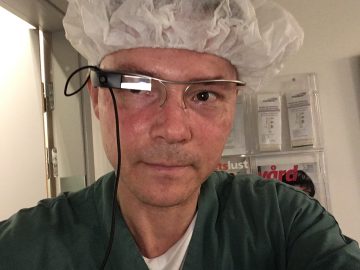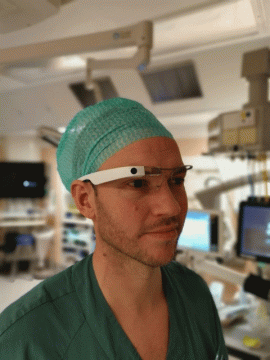
TECHNOLOGY AND HEALTH. Imagine a pair of glasses that can display important data, livestream the field of vision, react to voice control, show videos, and be used like a phone to talk to people in other rooms. The technology exists and is called augmented reality, or AR. A research project is now looking at how smart glasses can be used in anesthesia care at the Institute of Health and Care Sciences.
AR, augmented reality, refers to hardware that provides an enhanced version of reality. Some examples of how AR is already used in our society include the mobile game Pokemon Go, a speedometer in the windshield of some cars, and apps that enable you to try out furniture in your actual home environment before buying it.

Share what you see
In a research project conducted by Associate Professor Pether Jildenstål and doctoral student Per Enlöf, AR is used to augment the environment in anesthesia care. Using a pair of smart glasses, the user receives information directly related to the patient in question. The glasses stream information about vital functions like electrocardiograms, heart rate, oxygenation, blood pressure, and carbon dioxide. The glasses have a small prism that shows the desired data in real time in the field of vision. Users can decide for themselves where to display the information in the field of vision and what it will look like. This allows the user to continuously monitor data while doing other things, such as mixing a medicine or talking to colleagues.
The glasses also enable users to share what they see with people and other users in other physical places. A nurse anesthetist can wirelessly communicate assessment data in real time to a responsible anesthesiologist, even if they are in another location. In addition to more informed remotely made decisions, it provides flexibility. Medical doctors or other skilled practitioners do not need to come to the room. This creates the potential for both faster and better decisions, Per Enlöf and Pether Jildenstål believe, which benefits both the work environment and patient safety.

“Where the glasses look, other people can see. For example, they can observe a doctor performing a physical procedure on a patient or demonstrating an operation for educational purposes, in addition to receiving important data. It provides an overall picture,” says Pether Jildenstål.
The glasses used in the project are voice-controlled in the same way as a telephone, says Per Enlöf. “You can use voice commands when controlling them, and you can communicate to other users. You can also stream films. Those you communicate with can have either their own smart glasses or a screen. You can decide how to best use the glasses, but in principle two people in different places can see through each other’s glasses. One advantage with the glasses is being able to have your hands free so you can work with other things at the same time. You can also receive data in real time.”
New ways of working
The project is expected to contribute to better monitoring of patients because the glasses provide access to information whatever the user is working at the moment.
“This can contribute to better communication within the team that works with the patient. Through improved monitoring and communication and the ability to make better decisions at a distance, users can shorten the time between problems arising and deciding to perform an action. This provides higher patient safety and a more efficient use of resources,” says Enlöf.
“I envision this leading to new ways of working, both in terms of care density and the skills needed in the team,” Jildenstål says. “You can change the composition of the team, bring in an expert or keep it simple. This will obviously have a positive impact on costs and resources. With this type of equipment, you need less monitoring hardware and reduce the risk of things breaking or falling to the floor during transport.”
Enlöf believes smart glasses offer many benefits.
“If you apply this in a good way, it is also conceivable that you can reduce the risk of infection for both patients and staff by not touching the equipment with your fingers. If this even has only a small effect, it could contribute to less sick leave among staff and to a safer environment for patients when staying in hospitals. If you can save one day of care for a patient, this produces major financial savings.”
Just enough information
The project evaluates different software and hardware to see what works best. Different glasses provide different amounts of information.
“When you receive a lot of information, there is always a risk of information overload, which can have negative consequences for those who have to make decisions. For that reason, we have two types of glasses that we study to assess which variety is more suitable for the anesthesia staff,” says Jildenstål. He adds that it will be interesting to find out if having as much information as possible is best, or if “just the right amount” is better. How much information do you want and how should it be presented?
A challenge in the project has been to make the technology work optimally. This involves both building software suited for the glasses that gives them high functionality and developing the layout that suits the user.
“All this requires development work, and there has been considerable effort to make the technology work the way we want so we can start collecting data,” says Enlöf.
One of the project’s publications* deals with what the staff thinks about working with these types of glasses. The results have shown that there is potential, but some things can be improved with respect to how the information is presented and where in the field of view it is located.
“We need to take a closer look at user-friendliness and layout. But there is unanimity that this has great potential. It is not about replacing the human assessment or the clinical view, but it is an aid, a tool, for becoming more effective,” says Enlöf.

Innovation takes time
“We feel that it is very exciting and stimulating to work with the information technology side. We have had a very good collaboration, and it has broadened our views to gain other perspectives,” says Enlöf.
“The technology has to work for this to be implemented. One lesson has been that you need to think in new ways, and you need to find the best approach for you. We need to develop new ways of working, which can be both fun and frustrating, but above all it takes time.”
“You often have a picture yourself of how you want it to turn out, but by discussing matters with the developers, you will find new openings. Bringing our different worlds together produces synergies,” Jildenstål believes.
AR is here to stay
Per Enlöf maintains that this type of technology could be used in the entire healthcare system.
“Sometimes we think of other clinical activities where this would be good, like in trauma rooms where you may need quick decisions or in complicated operations. It could also be effective for educational purposes. For example, a surgeon could livestream his work to an unlimited number of students.” Ideas pop up all the time.
“When we receive completely new equipment, we are unfamiliar with, we need to adapt, and it can take time to feel confident about it,” says Jildenstål. “I am convinced that this is a very important step–making decisions in the near future is where we want to go, and this is part of the transformation. There are always different opinions about how to proceed, and that underscores the importance of research studies producing facts we can base our decisions on. I would be surprised if people choose not to implement this, because we will have plenty of research to base our decisions on.”
“The technology of transmitting information wirelessly is the future, and it will happen in some form,” concludes Per Enlöf.
*Title: Smart Glasses for Anesthesia Care: Initial Focus Group Interviews with Specialized Health Care Professionals; Journal of PeriAnesthesia Nursing.
BY: LOVISA AIJMER
INSTITUTE OF HEALTH AND CARE SCIENCES










